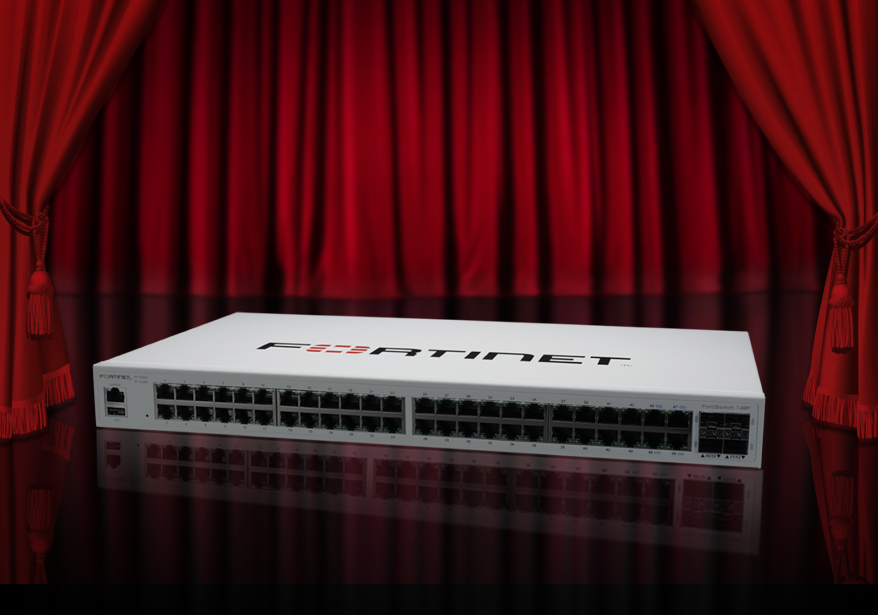
Fortinet’s new FortiSwitch 148F series managed switches are a new Layer 2 (Data Link) series of networking appliances. We are going to check out this new series. However, first a few words on switches generally.
Basically, a switch is a device that takes in packets (of data) being sent by devices that are connected to its physical ports and sends them out again. However, it sends them only through the ports that lead to the devices the packets are intended to reach. In other words, switches connect Ethernet IP devices and forward information between them. In it’s simplest form, an unmanaged switch is a glorified ethernet hub, and can be had quite cheaply. As such, an unmanaged switch requires no configuration. They are typically for basic connectivity. Often, you’ll see them used in home networks or wherever a few more ports are.
On the other hand, a managed switch is designed to communicate across multiple networks while simultaneously providing built-in network security and improving the network’s bandwidth by prioritizing packet requests.
Why a managed switch?
There is no ability to configure an unmanaged network switch because it lacks a “brain.” A managed switch gives you the ability to manually configure, monitor, and manage the devices on your network.
The reason an organization would spend good money on a managed switch with all these heavy-duty features is simply this: managed switches give you greater security, more features, and flexibility. Consequently, you can configure them to custom-fit your network. With this greater control, you can better protect your network and improve the quality of service for those who access the network.
Plus, a managed switch has more software on it that allows the user to have more control over their network. For example, you can use a managed switch to control the LAN to create VLANs (Virtual Local Area Networks).
In addition, managed switches provide network status, diagnostics, and data prioritization. With a managed switch, unauthorized devices cannot be connected to the network, thus preventing malicious threats.
How do I manage all these functions?
A good switch should be simple to set up and manage. The FortiSwitch 148F (and all FortiSwitches) is tightly integrated into the Fortinet Security Fabric via FortiLink. FortiLink is an innovative proprietary management tool. So, any FortiGate can seamlessly manage any FortiSwitch. As a result, the switch becomes a logical extension of the FortiGate.
Resultingly, the 148F is integrated directly into the Fortinet Security Fabric. And, it can be managed directly from the familiar, easy-to-grasp FortiGate GUI. The nice thing is, it’s a “single pane of glass” interface. It provides complete visibility and control of users and devices no matter how they connect.
The reporting and monitoring between the FortiGate and FortiSwitch is superb. One of the most valuable features is that you can completely isolate devices that are compromising the network.
Difference between the FS124E/FS148E PoE, and the FS124F/FS148F PoE
The 124E-POE and 148E-POE only provide power on half of the switch ports (ports 1-12 on the 124E-POE, ports 1-24 on the 148E-POE). Some other vendors do this too. The reason for it is simply cost engineering. Higher-end models that offer PoE on all ports simply have differing power demands. To power only half the ports on some models makes sense when you are targeting SMB-sized budgets.
Another thing, the 148F introduces 10GE capable SFP+ uplinks paired with 48 1GE access ports into our entry level platform, whereas the 148E has 1GE SFP uplinks.
Performance of the FortiSwitch 148F
The FS-148F has 48x GE RJ45 and 4x 10GE SFP+ ports. It delivers 176 Gbps of Switching Capacity, and 260 Mpps (Packets per Second -Duplex). Additionally, network latency is < 1µs. Lastly, it supports 4000 VLANS. It carries 512 MB of DDR3 RAM, and 64 MB of Flash memory.
The FS148F PoE has 24 PoE ports and a power budget of 370W, the FS148 FPoE has 48 PoE ports and a power budget of 740W.
Features of the FS148F
Some features include Flow control, auto-negotiation, port mirroring, SNTP support, Link Aggregation Control Protocol, and IPv6 management. In addition, there’s Protocol support, DHCP client, VLAN Tagging, and a lot more.
Who is the FS148F designed for?
The 148F series is ideal in converged network environments; enabling voice, data and wireless traffic to be delivered across a single network. Specifically it will suit threat conscious mid-sized to large businesses and branch offices.
Networks today are essential for supporting businesses, providing communication, delivering entertainment—the list goes on and on. And building a small business network is not possible without switches to tie devices together. It unites the computers, printers, and servers in a small business network seamlessly and safely. So if you have any questions, give Corporate Armor a call at 877-449-0458 or email us at [email protected].
FortiSwitch 148F Highlights
48x GE RJ45 and 4x 10GE SFP+ ports
176 Gbps of Switching Capacity
260 Mpps (Packets per Second -Duplex)
Supports 4000 VLANS
